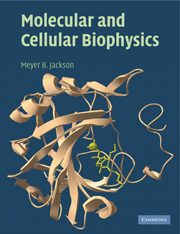Book contents
- Frontmatter
- Contents
- Preface
- Acknowledgements
- Chapter 1 Global transitions in proteins
- Chapter 2 Molecular forces in biological structures
- Chapter 3 Conformations of macromolecules
- Chapter 4 Molecular associations
- Chapter 5 Allosteric interactions
- Chapter 6 Diffusion and Brownian motion
- Chapter 7 Fundamental rate processes
- Chapter 8 Association kinetics
- Chapter 9 Multi-state kinetics
- Chapter 10 Enzyme catalysis
- Chapter 11 Ions and counterions
- Chapter 12 Fluctuations
- Chapter 13 Ion permeation and membrane potential
- Chapter 14 Ion permeation and channel structure
- Chapter 15 Cable theory
- Chapter 16 Action potentials
- Appendix 1 Expansions and series
- Appendix 2 Matrix algebra
- Appendix 3 Fourier analysis
- Appendix 4 Gaussian integrals
- Appendix 5 Hyperbolic functions
- Appendix 6 Polar and spherical coordinates
- References
- Index
Chapter 2 - Molecular forces in biological structures
Published online by Cambridge University Press: 24 May 2010
- Frontmatter
- Contents
- Preface
- Acknowledgements
- Chapter 1 Global transitions in proteins
- Chapter 2 Molecular forces in biological structures
- Chapter 3 Conformations of macromolecules
- Chapter 4 Molecular associations
- Chapter 5 Allosteric interactions
- Chapter 6 Diffusion and Brownian motion
- Chapter 7 Fundamental rate processes
- Chapter 8 Association kinetics
- Chapter 9 Multi-state kinetics
- Chapter 10 Enzyme catalysis
- Chapter 11 Ions and counterions
- Chapter 12 Fluctuations
- Chapter 13 Ion permeation and membrane potential
- Chapter 14 Ion permeation and channel structure
- Chapter 15 Cable theory
- Chapter 16 Action potentials
- Appendix 1 Expansions and series
- Appendix 2 Matrix algebra
- Appendix 3 Fourier analysis
- Appendix 4 Gaussian integrals
- Appendix 5 Hyperbolic functions
- Appendix 6 Polar and spherical coordinates
- References
- Index
Summary
In Chapter 1 the global conformation of a protein was treated like a black box, without worrying about the internal machinations. This approach is useful in interpreting many kinds of experiments, but if we want to make use of detailed structural information about a macromolecule, we have to open up the black box and look inside. To do this we need to understand the molecular forces that act within a macromolecule. These forces govern how a protein folds, and which of its different conformations will predominate. Similar forces determine the structures of nucleic acids and lipid bilayers, and also drive the associations between macromolecules and ligands.
The forces at work in biological systems can be divided into various categories and examined in turn. They are generally well understood to the extent that good approximate mathematical expressions are available. Much is known about their relative strengths under various conditions. However, it must be emphasized that the structure and dynamics of biological macromolecules are determined by the interplay of many forces. This complexity makes it difficult to investigate these forces by studying the biological molecules directly. We therefore often turn to model systems that are very unbiological but nevertheless instructive. The results from model systems enable us to break these complicated problems down into simpler ones.
The Coulomb potential
One of the fundamental tenets of electricity is that point charges interact with a potential energy that is inversely proportional to the distance of separation, r, and directly proportional to the product of the two charges, q1 and q2.
- Type
- Chapter
- Information
- Molecular and Cellular Biophysics , pp. 25 - 55Publisher: Cambridge University PressPrint publication year: 2006



